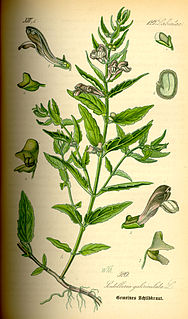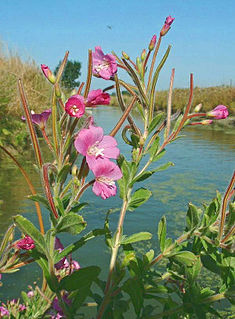
Chamaenerion angustifolium is a perennial herbaceous flowering plant in the willowherb family Onagraceae. It is known in North America as fireweed, in some parts of Canada as great willowherb, in Britain and Ireland as rosebay willowherb. In the United Kingdom it is also known as bombweed, as a result of its rapid appearance on city bomb sites during the Blitz of World War II. It is also known by the synonyms Chamerion angustifolium and Epilobium angustifolium. It is native throughout the temperate Northern Hemisphere, including large parts of the boreal forests.

The grey pug is a moth of the family Geometridae. It is found throughout the Palearctic region. It is also found in North America.Since it does not place any special demands on climatic conditions, special caterpillar food plants, geological subsoil or the like it is a typical species of almost any Hochstaudenflur, where it occurs in the herb layer, in bushes and even on deciduous trees. It can be found on forest edges and hedgerows, on heath, in rocky places and wetlands, parks and gardens, as well as in villages and town centres.

The Arboretum & Botanic Garden at the University of California, Santa Cruz, is located on the campus of the University of California, Santa Cruz, in the United States.

Epilobium is a genus of flowering plants in the family Onagraceae, containing about 197 species. The genus has a worldwide distribution. It is most prevalent in the subarctic, temperate and subantarctic regions, whereas in the subtropics and tropics Epilobium species are restricted to the cool montane biomes, such as the New Guinea Highlands.

Scutellaria galericulata, the common skullcap, marsh skullcap or hooded skullcap, is a hardy perennial herb native to northern areas of the Northern Hemisphere, including Europe, Asia, and almost all of Canada. It is a member of the mint family. The form is upright and is usually 20 to 45 centimeters in height, sometimes reaching up to 80. It is a wetland-loving species and grows along fens and shorelines. The blue flowers are 1 to 2 centimeters long. The flowers are in pairs and are all on the same side of the stem. The flowers do not appear at the top of the stem.

Epilobium montanum or Broad-leaved Willowherb is a species of flowering plant in the willowherb family Onagraceae.

Epilobium hirsutum is a flowering plant belonging to the willowherb genus Epilobium in the family Onagraceae. It is commonly known as the great willowherb, great hairy willowherb or hairy willowherb. Local names include codlins-and-cream, apple-pie and cherry-pie.

Epilobium ciliatum, known by the common names fringed willowherb, American willowherb, slender willow herb, and northern willow herb is a species of flowering plant in the willowherb family Onagraceae. This species is native to much of North America, southern South America, and East Asia. It is an introduced species in much of Eurasia and Australia.

Epilobium clavatum is a species of flowering plant in the evening primrose family known by the common names talus willowherb and clavatefruit willowherb. It is native to western North America from Alaska to northern California to Colorado, where it grows in rocky high mountain habitat such as talus. It is a clumping perennial herb forming bristly mounds up to about 20 centimeters high and spreading outward via tough stolons. The oval-shaped leaves are 1 to 3 centimeters long. The inflorescence is an erect raceme of flowers, each with four small pink petals. The fruit is a capsule up to 4 centimeters long.
Epilobium foliosum is a species of flowering plant in the evening primrose family known by the common names leafy willowherb and California willowherb. It is native to parts of western North America from British Columbia through California to Arizona, where it grows in many types of habitat, including disturbed areas.
Epilobium howellii is an uncommon species of flowering plant in the evening primrose family known by the common names Yuba Pass willowherb and subalpine fireweed. It is endemic to the High Sierra Nevada of California, where it is known from only about 20 occurrences.

Epilobium oregonense is a species of flowering plant in the evening primrose family known by the common name Oregon willowherb. It is native to western North America from British Columbia to Arizona, where it generally grows in moist places in several types of habitat. It is a perennial herb growing spindly erect stems approaching 40 centimeters high or sometimes forming mats spreading via stolons. The small leaves are rounded near the base of the plant and linear in shape farther up the stem. The inflorescence bears flowers with four white to pink petals each a few millimeters long. The fruit is an elongated capsule up to 5 centimeters in length which is borne on a long pedicel which may be longer than the capsule itself.

Redcar Field is a Site of Special Scientific Interest in the Darlington district of County Durham, England. It is situated just north of Darlington, about 1 km south of the village of Coatham Mundeville.
Epilobium brunnescens is a flowering plant belonging to the willowherb genus Epilobium in the family Onagraceae. It is a small, creeping, perennial plant with white or pale pink flowers. It is native to New Zealand and south-east Australia and has been introduced to Northern Europe. Its common names include New Zealand willowherb in Great Britain and Ireland, creeping willowherb in New Zealand and bog willowherb for the Australian subspecies.
The name creeping willowherb can refer to several species of flowering plant:

Epilobium hirtigerum, commonly known as the hairy willow herb, is a species in the family Onagraceae that is endemic to south western Australia.

Epilobium tetragonum, commonly known as the square stalked willow herb, is a species of flowering plant in the willowherb family Onagraceae.

Epilobium coloratum, known by the common names purpleleaf willowherb and cinnamon willow-herb, is a species of flowering plant in the genus Epilobium of the willowherb family Onagraceae. This species is native to the Midwest and Eastern United States, as well as the Canadian provinces of Ontario, Québec, New Brunswick, Nova Scotia, and Newfoundland. It is also native to the Dominican Republic and Haiti.














